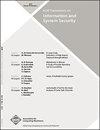组播身份验证应用的身份验证纠错码
Q Engineering
ACM Transactions on Information and System Security
Pub Date : 2010-02-01
DOI:10.1145/1698750.1698757
引用次数: 8
摘要
我们考虑对网络上传输的数据包流进行身份验证的问题,攻击者可能对流进行任意攻击:他可能丢弃或修改选择的数据包,以任何方式重新排列数据包的顺序,并向流注入新的,随机的或特制的数据包。相比之下,先前关于多播身份验证问题的工作主要集中在一个不太强大的对抗网络模型上,或者研究了一个具有特定时间或网络结构假设的限制性更大的设置。我们用两个参数来模拟网络修改n个数据包流的能力:存活率α (0 <α≤1)表示保证未修改地到达任何特定接收器的数据包的比例,泛洪率β (β≥1)表示在任何特定接收器接收的流的大小可能超过发送流的大小的因素。将纠错码与标准加密原语相结合,我们的方法提供了几乎相同的安全保证,就好像每个数据包都单独签名一样,但只需要对整个流进行一次签名操作,并且只向每个传输的数据包添加少量与β/α2成比例的认证信息。我们证明了我们的方案的安全性和正确性,并从通信开销和发送方和接收方的计算工作量方面分析了它的性能。我们的结果演示了如何在底层通信通道的公钥模型和有界计算模型中将列表解码转换为无二义解码。总的来说,我们的技术提供了一种独立的身份验证纠错代码,可能在其他设置中很有用。本文章由计算机程序翻译,如有差异,请以英文原文为准。
Authenticated error-correcting codes with applications to multicast authentication
We consider the problem of authenticating a stream of packets transmitted over a network controlled by an adversary who may perform arbitrary attacks on the stream: He may drop or modify chosen packets, rearrange the order of the packets in any way, and inject new, random, or specially crafted packets into the stream. In contrast, prior work on the multicast authentication problem has focused on a less powerful adversarial network model or has examined a considerably more restrictive setting with specific timing or structural assumptions about the network.
We model the ability of the network to modify a stream of n packets with two parameters: the survival rate α (0 <α≤ 1) denoting the fraction of the packets that are guaranteed to reach any particular receiver unmodified and the flood rate β (β ≥ 1) indicating the factor by which the size of the received stream at any particular receiver may exceed the size of the transmitted stream. Combining error-correcting codes with standard cryptographic primitives, our approach gives almost the same security guarantees as if each packet were individually signed, but requires only one signature operation for the entire stream and adds to each transmitted packet only a small amount of authentication information, proportional to β/α2. We prove the security and correctness of our scheme and analyze its performance in terms of communication overhead and computational effort at the sender and the receiver. Our results demonstrate how list decoding can be transformed into unambiguous decoding in the public-key model and the bounded computational model for the underlying communication channel. Overall, our technique provides an authenticated error-correcting code of independent interest that may be useful in other settings.
求助全文
通过发布文献求助,成功后即可免费获取论文全文。
去求助
来源期刊

ACM Transactions on Information and System Security
工程技术-计算机:信息系统
CiteScore
4.50
自引率
0.00%
发文量
0
审稿时长
3.3 months
期刊介绍:
ISSEC is a scholarly, scientific journal that publishes original research papers in all areas of information and system security, including technologies, systems, applications, and policies.
 求助内容:
求助内容: 应助结果提醒方式:
应助结果提醒方式:


